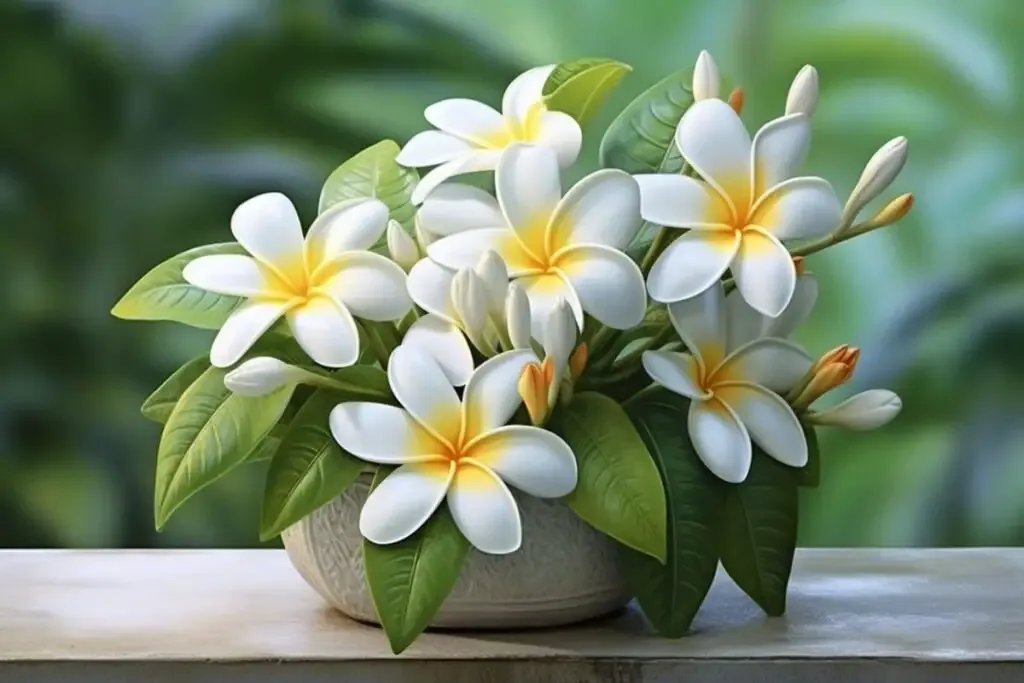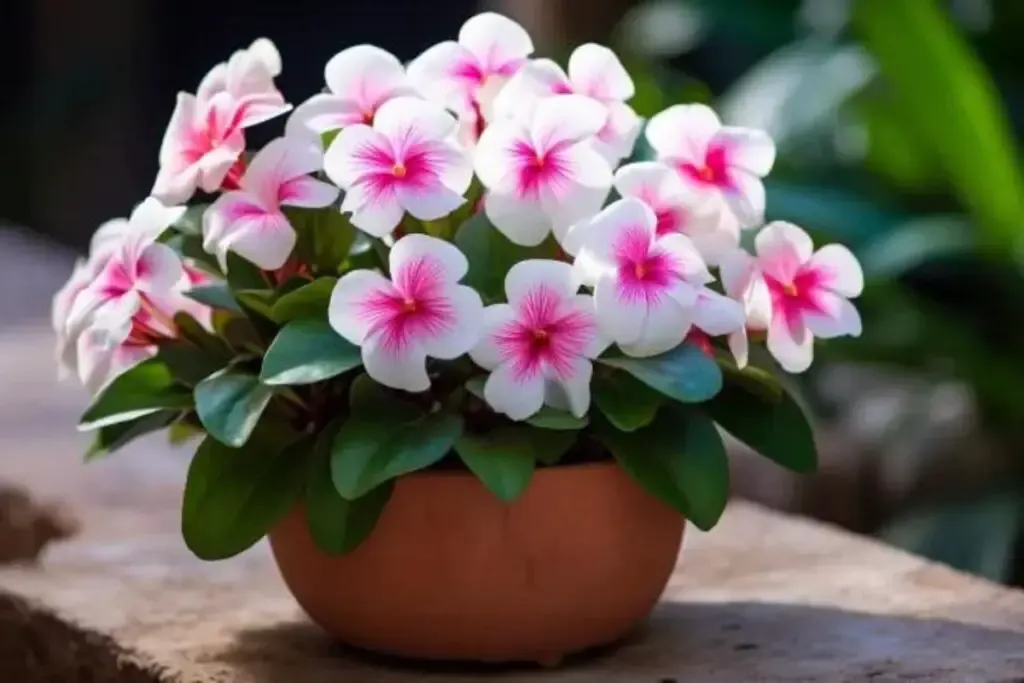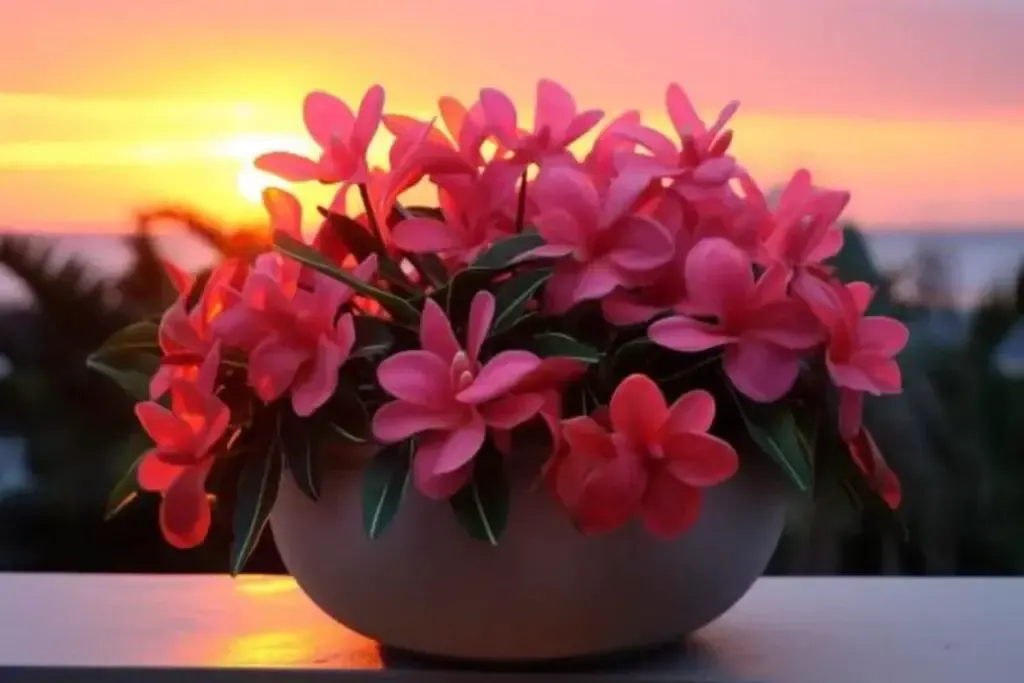Plumeria, also known as frangipani, is a tropical beauty that evokes images of lush Pacific islands and sweet, delicate fragrances.
These flowering plants are often associated with garden landscapes, but did you know that with the right approach, you can grow them in pots, making them perfect for porches, patios, and even as indoor specimens?
As an avid gardener and blogger with a passion for cultivating tropical blooms in non-tropical settings, I’m here to guide you through the process of growing plumeria in pots—turning your space into an exotic paradise, no matter where you live.
Does Plumeria Grow Well in Pots?
Absolutely! Plumeria plants are quite adaptable and can thrive in pots when given proper care. Growing plumeria in containers allows for flexibility in managing sunlight, watering, and feeding.
Plus, it gives you the power to move your plants around to create that perfect aesthetic or to protect them from harsh weather conditions.
The key to success lies in the size of the pot, the soil mixture, and understanding the watering needs of these drought-tolerant plants. With a well-draining pot and a little attention to detail, your potted plumeria can flourish and bloom just as brilliantly as it would in the ground.
Best Plumeria Varieties for Pots
Not all plumeria varieties are created equal when it comes to container gardening. Some are naturally more compact or have root systems that adapt better to the confines of a pot.
Let’s dive into a few of the best varieties for your potted tropical paradise.
1. Celadine

The ‘Celadine’ plumeria is a classic choice with vibrant yellow-centered white flowers that emit a strong, sweet fragrance. This variety is known for its vigorous growth and high resistance to disease, making it a robust option for new plumeria enthusiasts.
‘Celadine’ can be easily managed with regular pruning to maintain a size suitable for pots, ensuring it doesn’t outgrow its home while still providing a generous display of blooms.
2. Pink Pansy

For those who adore a splash of color, ‘Pink Pansy’ is a delight. This variety showcases lovely pink blooms with a soft, inviting fragrance. It’s a compact grower, which naturally makes it an excellent candidate for container planting.
What’s more, ‘Pink Pansy’ is a prolific bloomer. With adequate light and the right care, this plumeria will reward you with its cheerful flowers throughout the growing season.
3. Hawaiian Sunset

The ‘Hawaiian Sunset’ variety is a breathtaking choice with its gradient orange to pink flowers that truly resemble a tropical sunset.
This variety tends to have a more bushy growth habit, which is ideal for pot culture. ‘Hawaiian Sunset’ is a bit of a show-off with its generous blooming, and when given enough sunlight, it can become the centerpiece of your potted garden collection.
How to Grow and Care For Plumeria in Pots
Growing plumeria in pots might seem like a tropical challenge, but with the right approach, even a novice gardener can enjoy the exotic allure of these blossoms.
Let’s explore how you can nurture your plumeria to full bloom.
Planting
Planting plumeria is an exciting endeavor. Start with a cutting or a young plant from a reputable nursery. If you’re planting a cutting, allow the cut end to callous over for a few days before planting to prevent rot.
Place the cutting about 2 to 4 inches deep in the soil and support it with a stake if necessary. For potted plants, ensure the root ball is placed just below the soil surface and the pot has enough depth to accommodate growth.
Pot Size
Choosing the right pot size is crucial for plumeria. Initially, a pot that’s 12-14 inches in diameter is usually sufficient. However, as the plant grows, you may need to upgrade to a larger size.
The pot should be just big enough to accommodate the root system but not so large that the soil stays wet for too long. Remember, plumeria likes to be snug but not squeezed.
Light
Plumeria loves light—lots of it! They thrive in full sun, with at least 6 hours of direct sunlight a day. If you’re growing them indoors, a south-facing window is ideal, or consider using grow lights to supplement.
When outdoors, rotate the pots regularly to ensure even exposure and prevent leaning.
Soil
The right soil mix is vital for plumeria in pots. Use a well-draining potting mix with perlite or sand added to ensure good drainage.
You can also use a mix specifically designed for cacti and succulents, as it typically has the drainage properties plumeria needs.
Water
Plumeria’s watering needs are moderate. They prefer to dry out a bit between waterings, so check the soil’s moisture level before adding water.
Overwatering can lead to root rot, the archenemy of plumeria. Cut back on watering in the winter when the plant is dormant.
Temperature and Humidity
These tropical beauties prefer warm temperatures and moderate humidity. They can handle temperatures down to about 50°F (10°C), but they thrive between 60-85°F (16-29°C).
If you live in a cooler climate, bring your plumeria indoors when the temperature dips. Humidity is their friend, so if the air in your home is dry, consider a humidity tray or occasional misting.
Fertilizer
Feeding your plumeria is like giving them a gourmet meal—they love it! Use a high-phosphorus fertilizer every two to three weeks during the growing season to encourage blooming.
Reduce feeding in the fall and stop in the winter when the plant is resting.
Pruning Potted Plumeria
Pruning is an essential aspect of plumeria care, particularly for potted plants, as it helps maintain their shape and encourages more vigorous growth. The best time to prune your plumeria is in the early spring, just before new growth begins.
Start by removing any damaged or diseased branches to keep the plant healthy. Then, shape the plumeria by trimming the branches to promote a more balanced structure. Keep in mind, though, that plumeria blooms on the terminal ends of the branches, so excessive pruning can reduce the number of flowers.
One tip is to prune just above the point where you see a ‘Y’ in the branch. This encourages the plant to branch out more, which can result in a fuller plant with more blooms. Don’t be afraid to give your plumeria a good trim; they are quite resilient and will bounce back with lush growth.
Remember to always use clean, sharp pruning tools to make clean cuts. This will help prevent infection and allow the plant to heal more quickly. And don’t throw away those cuttings! Plumeria cuttings can be used to propagate new plants.
Overwintering
When temperatures begin to drop, it’s time to prepare your plumeria for overwintering, especially if you’re in a region that experiences cold winters. Plumeria plants are tropical and can be damaged by temperatures below 50°F (10°C). Here’s how to overwinter your potted plumeria:
- Reduce Watering: As the days shorten and temperatures cool, your plumeria will enter a dormant phase. Gradually reduce watering to prevent rot, as the plant won’t absorb as much moisture during this time.
- Move Indoors: Before the first frost, move your plumeria indoors to a location where it can get plenty of light, such as a sunny window. If you don’t have enough light indoors, a grow light can work wonders.
- Temperature Control: Keep the plant in a cool, dry place where temperatures remain above 50°F (10°C). A garage or basement can often provide the right conditions, as long as the plant is kept away from freezing.
- Leaf Drop: Don’t be alarmed if your plumeria drops its leaves during winter; this is a normal part of its dormant cycle. Keep an eye on the woody stems; they should remain firm. If they become soft or mushy, that’s an indication of a problem, potentially rot.
- Light Watering: Water sparingly throughout the winter, only when you notice the soil is completely dry. Overwatering during dormancy is a common mistake that can lead to root rot.
- Prepare for Spring: As winter comes to an end, gradually reintroduce your plumeria to more light and water, preparing it to move back outdoors once the danger of frost has passed and the temperatures consistently stay above 50°F (10°C).
With these pruning and overwintering strategies, your potted plumeria will not only survive but thrive year after year, bringing a tropical vibe to even the coldest of climates when the summer sun returns.

